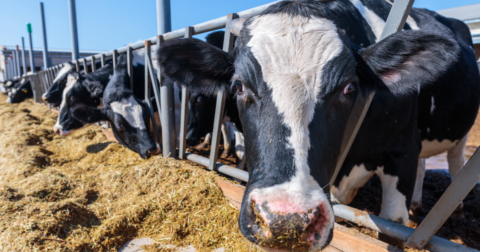Perspective
Critics Declared Veganism Dead in 2025. Here’s What Those Obituaries Are Missing.
Food•5 min read
Explainer
It might be a faraway scenario — but it’s one worth examining.


Words by Seth Millstein
Factory farming is a destructive process that erodes the land, pollutes the air and inflicts untold suffering on animals. As more and more people learn about the disturbing realities of factory farming, efforts to reduce or eliminate the process have strengthened. A 2017 poll by the Sentience Institute found that 49 percent of Americans support a complete ban on factory farms, and a federal bill to do exactly that is slowly gaining steam in Congress. Which raises an interesting question: how would the end of factory farming impact animals around the world?
Factory farming — individually known as Concentrated Animal Feeding Operations, or CAFOs — is a form of intensive agriculture that aims to produce animal products using as few resources as possible. This is accomplished by cramming large numbers of animals into confined spaces that severely restrict their movement, and in many cases, forcing them to live their entire lives indoors.
One-third of all land on Earth is used for livestock production, according to the UN, and the overwhelming majority of that production comes from factory farms. A study by the Sentience Institute found that around 99 percent of U.S. livestock is factory farmed, while Our World In Data estimates that 94 percent of livestock around the world lives and dies on factory farms. In total, an estimated 100 billion animals a year die on factory farms.
Although factory farms are economically efficient, demand for cheap meat has plenty of downsides. The livestock industry is responsible for around 14 percent of all greenhouse gasses — most of which are driven by land use and cattle burps. A whopping 37 percent of all methane emissions come from meat. That latter number is especially worrisome, as methane has 23 times the global warming potential of CO2, depending on the scale used.
Factory farms also wreak havoc on land and wildlife. Livestock production is one of the main causes of topsoil erosion, which occurs when land is farmed too quickly and intensively, without giving it proper time to recover the topsoil nutrients necessary to support life.
Over time, the ever-expanding factory farm industry has deforested massive amounts of land to make way for new farms; this is most starkly illustrated in the Amazon, where 70 percent of previously forested land is now occupied by pastures. Ironically, the deforestation process itself also erodes topsoil, making this something of a vicious cycle. In addition, soil erosion and nitrates from fertilizer also pollute nearby waterways, causing harmful algae blooms that contaminate drinking water and cause mass die-offs among fish. And deforestation also destroys the planet’s most effective nature-based climate solutions — forests, savannas, peatlands and other wild landscapes that are truly able to store carbon in the ground rather than release it into the atmosphere.
Factory farms also inflict immeasurable suffering on the animals unfortunate enough to be confined in them. Take poultry farms, for instance. Chickens in such farms have their beaks sliced off hours after their birth, a painful process that also causes chronic pain for months afterward. After living the rest of their lives in cages so small that they can’t fully extend their wings, they’re shackled into stirrups that often break their legs, then thrown into an electrified bath of water that’s meant to stun them (but often fails to do so). Finally, their throats are slit.
That’s just poultry. Dairy cows are artificially impregnated constantly to ensure a constant stream of milk production, and their newborns are taken away from them in order to prevent them from drinking that milk. Pigs, cows, sheep and goats are routinely castrated without anesthetic. Infectious disease is common on factory farms; to fight disease outbreaks, farmers pump their animals full of antibiotics, which eventually results in antibiotic-resistant diseases that can be passed to humans.
Given all of this, it’s no surprise that efforts to ban or reduce factory farming have gained support in recent years. In 2019, Sen. Cory Booker introduced the Farm System Reform Act, which would ban all factory farms by 2040. A counterpart bill was soon released in the House of Representatives, and it now has 37 sponsors. However, the legislation faces a steep uphill climb in Congress: as of this writing, only five senators have pledged to support it.
One innovative route to ending factory farms is cultivated meat, which requires no slaughtered animals to produce. The technology of cultivated meat has improved by leaps and bounds over the last decade. While it’s not yet affordable enough to be commercially viable, its proponents say it’s likely only a matter of time until it is.
All this context brings us back to our original question: what would happen to animals if factory farming ended?
Attempting to answer this requires a good degree of speculation, as the complete elimination of factory farming would be nothing less than a seismic shift for humanity and animals alike. The impact would be cascading and continuous, and it’s impossible to predict all of the direct and indirect effects that such a change would have on animal life worldwide. The outcome would also depend in large part on how policymakers, industry leaders and consumers responded to the change.
While much on this topic is highly speculative, there are some things that we can say with confidence: every year, 100 billion animals are born and bred for the sole purpose of populating factory farms; if factory farming ceased to exist, these animals wouldn’t be born. As such, ending factory farming would presumably cause a sharp reduction in animal life around the globe, at least in the short term.
Or would it? This is where things get complicated. As previously mentioned, factory farms have a ripple effect that extends far beyond their physical borders. In addition to farmed animals, wild animal populations are significantly impacted by the activities of factory farms, both directly and indirectly. The elimination of factory farming, then, would allow these populations to flourish and thrive to a degree that they simply can’t under the current system.
In 2018, for instance, over 2.6 million wild animals were killed in the U.S. in order to make way for factory farms, according to data from the U.S. Department of Agriculture. The harmful algae blooms caused by topsoil erosion result in mass fish die-offs, and in the Australian state of New South Wales, over 87 million animals were killed by deforestation between 1998 and 2015, according to a study by the World Wildlife Foundation. There are around 3 billion fewer birds on the planet today than there were in 1970; according to a 2023 study, the use of fertilizer and pesticides in agriculture is the leading cause of this decline.
It’s also worth taking a step back and looking at the long-term effects factory farms have on biodiversification. Every day, 137 species of animals, insects and plants go extinct due to deforestation, according to the World Animal Foundation. Over the course of three decades in the Amazon, deforestation has caused the extinction of 10 mammalian species, 20 bird species and eight amphibian species, according to the foundation. A 2021 study found that, of the 28,000 species currently at risk of extinction, 24,000 are at risk primarily due to animal agriculture.
All of this is a long way of saying that the runoff effects of factory farms indirectly kill millions of animals around the world every year, and cause many species to go extinct entirely. If factory farming ended tomorrow, those animals wouldn’t be dying, and those species wouldn’t be going extinct.
It would be highly impractical to eliminate factory farming all at once, due to the sheer number of animals currently living in factory farms and the massive amount of meat people in the global north still eat. Those animals would need somewhere to go, and it’s not feasible to simply release 23 billion animals into the wild and hope everything works itself out. For that reason, it’s more likely that factory farming would eventually be gradually phased out, rather than abolished in one fell swoop.
Think, for example, of the invention of the car. Cars didn’t replace horse-drawn carriages overnight, but with their invention, over time, the use of horses for transport was mostly phased out. A similar phenomenon could play out in the meat industry, with consumers steadily reducing meat from their diet until it’s only a fraction of what it is now.
A gradual slowdown such as this is sometimes called a “just transition,” and it could play out in a variety of ways. For instance, if cultivated meat is eventually scaled en-masse — to the point at which it’s cheaper, healthier and more environmentally sustainable than factory farming — it’s likely we might see a similar sort of seismic-yet-gradual transition. Another potential tool for a just transition would be the reduction or elimination of economic and fiscal policies that support the traditional meat industry. Finally, just transition programs can help meat industry employees like slaughterhouse workers and contract farmers forge new career paths, which is already happening for some producers who now grow mushrooms and greens instead of raising livestock.
Whether or not there would ultimately be more or fewer animals on the planet in the absence of factory farming is difficult to say, but one thing is for sure: The animals that were alive, however numerous they were, would be living much happier and healthier lives than they are now.
The elimination of factory farms would affect much more than animals and the environment. It would also have a colossal impact on how we humans get and eat our food — especially with regard to meat.
Meat consumption has skyrocketed over the last several decades, and the proliferation of factory farms is in part a response to this increase in demand. Their abhorrent effects on the environment and animals notwithstanding, factory farms are economically efficient, and that efficiency (not to mention government subsidization of the meat and dairy industries) keeps prices lower than they otherwise would be. As such, meat would become significantly more expensive if factory farms were eliminated but cheaper cultivated meat did not replace animal farming.
Still, the eradication of factory farms would almost certainly lead to — or require, depending on how you look at it — a reduction in humans’ meat consumption. We simply would not be able to produce as much meat as we do now. But this is a positive side effect: humans already consume meat at an unsustainable and unhealthy rate, so a reduction in meat consumption would be an enormous win for the planet.
In the long-term, eliminating factory farms would change the world in monumental ways, most of which are impossible to game out with precision. We can’t know, for instance, exactly how the global animal population would be affected by the countless direct and indirect effects that ending factory farming would have. It’s also too soon to say how governments and the human population at large would adapt to the new reality, and how our consumption habits would change.
One thing is indisputable, though: If we ended factory farming, animal suffering and environmental devastation around the world would plummet. The number of animals forced to live their entire lives in violent, unforgiving, disease-ridden conditions would fall exponentially across the globe. Even if there were fewer animals on Earth as a result, the standard of living for those animals would improve enormously.